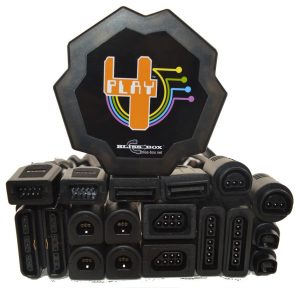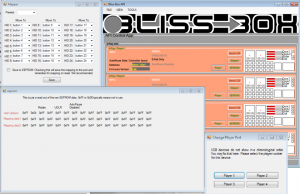And AI is more badass than ever!
See an animated GIF here of the AI.
Make sure you update your core…
And AI is more badass than ever!
See an animated GIF here of the AI.
Make sure you update your core…
We thank Eurogamer dearly for being one of the last bastions of journalism in the games industry and for breaking this story into the mainstream.
We want to especially thank Damien McFerran for covering this story in the first place and Byuu for participating in this story as well.
We encourage everybody to read this story –
The retro gaming industry could be killing video game preservation
We hope that the parties involved will feel more compelled now to treat this scene’s authors with the respect they deserve.
Out of the three parties involved, RetroBit so far has been willing to work with us in trying to remedy the problems with the launched product so far and come to a workable agreement between us and them. We applaud this and we hope that we will be able to resolve the issues in an amicable fashion.
We hope that this and other coverage of this ongoing problem will spell the end for the continued abuse of non-commercially licensed console emulators that continue to be sold on hardware devices like this, and that we can reach amicable solutions in the future with these companies when issues like these happen instead of us continuing to be ignored, and worst, even threatened to be sued unless we remove all articles mentioning their continued license violations. We will not be browbeaten here or cajoled and silenced, what is right is right, and this abuse has to end. We are completely 100% in the right in this situation.
 When it comes to 2D game development frameworks, there are many options out there for indie game developers. Every framework has its own pros and cons, and its own use cases. Today, let’s talk about LÖVE, baby.
When it comes to 2D game development frameworks, there are many options out there for indie game developers. Every framework has its own pros and cons, and its own use cases. Today, let’s talk about LÖVE, baby.
LÖVE is an awesome framework to make 2D games in Lua. With some modification, these games can be brought to libretro though Lutro. With the advent of C++14, are there tools and features we can bring in to improve the scripting experience behind developing 2D games?



Continue reading “ChaiLove – Another Take on 2D Game Development”
RetroArch 1.7.0 has just been released! Grab it here.
This latest version has also been uploaded to the Google Play Store.
We here at RetroArch/Libretro wish you a Merry Christmas and a Happy New Year!
If you’d like to show your support, consider donating to us. Check here in order to learn more.
– CHEEVOS: Add badges for achievements, shows thumbnail images of achievements.
– CHEEVOS: Leaderboard support.
– CHEEVOS: Only disable savestates on hardcore mode if achievements are not available.
– COMMANDLINE: Fix fullscreen toggle switch.
– COMMON: Add ‘Automatically Load Content To Playlist’ feature, enabled by default.
– COMMON: Fix slowmotion ratio always being reset back to 1.
– COMMON: Optimized NBIO implementations now for Apple, Windows, and Linux. Uses mmap for Linux/Windows/BSD if/when available. File I/O should now be much faster for loading images inside the menu.
– COMMON: Native Blissbox support now for latest firmware as of writing (2.0). Implementation through libusb and/or native Windows HID.
– COMMON: New lightgun API.
– COMMON: New VFS (Virtual File System) API.
– COMMON: Fixed some playlist bugs.
– COMMON: New snow shader.
– COMMON: Fix Quick Menu title, no longer shows ‘Select File’.
– COMMON: Fix loading cores that require no content one after another.
– COMMON: Map Delete key to Y button for non-unified menu keyboard controls.
– COMMON: Fix for relative paths being normalised and generating a duplicate history entry.
– EMSCRIPTEN: Fix references to browserfs.
– FREEBSD: Support libusb HID input driver.
– HAIKU: Buildfix.
– INPUT: Map clear button to DEL key.
– LINUX/X11: Add RetroArch logo to window title bar.
– LINUX/X11: Input driver now supports new lightgun code.
– LINUX/X11: Support window transparency (requires a compositing window manager).
– LOBBIES: Fix for crash on join netplay rooms via touch / glui.
– LOCALIZATION: Update Italian translation.
– LOCALIZATION: Update Japanese translation.
– LOCALIZATION: Update Portuguese-Brazilian translation.
– LOCALIZATION: Update Polish translation.
– LOCALIZATION: Update Russian translation.
– MENU: Snowflake menu shader effect.
– OSX/PPC: Fix the GL2 renderchain, had to use EXT versions of framebuffer/renderbuffer functions.
– PSP: Make it work with Vita’s Adrenaline.
– PSP: Fix audio sync.
– PSP: Fix content loading, port should be functional again.
– PSP: Use 64MB when available.
– SCANNER: Fix crash from Windows-incompatible format string.
– VITA: Improve packaging, installation times.
– WIIU: Disabled the controller patcher for now since it was the source of many stability issues.
– VULKAN: Various stability fixes for WSI.
– WINDOWS: Add MSVC 2017 solution.
– WINDOWS: Get rid of the empty console window in MSVC 2010 builds.
– WINDOWS: Raw input driver now supports new lightgun code.
– WINDOWS: Use configured OSD/text message color on GDI driver.
– WINDOWS/XINPUT: Populate XInput VID/PID from DInput so autoconfig doesn’t rely solely on joypad names
– WINDOWS/XINPUT: Fix crash that occurs in some situations with Steam running and a Steam Controller plugged in.
– WINDOWS: Improve version reporting under System Information.
– WINDOWS: Support window transparency.
– WINDOWS: Correct usage of GetWindowPlacement per MS docs, fixes game window position on Win95/98.
– WINDOWS: Added Visual Studio 2017 support.
Bliss-Box 4-Play integration for RetroArch will soon be here! https://t.co/JekUx2Gyz0 pic.twitter.com/lNbIrqiaVN
— libretro (@libretro) December 13, 2017
Grab the newest firmware for this device and you can enjoy out-of-the-box Blissbox support with RetroArch on the following platforms:
For more information, read this separate article here.
This is a legit game changer. This peripheral will allow you to use real physical gamepads from all sorts of different game consoles through one interface.
Right now, only one of these devices is supported.
GameDragon and @andress430 added badge images to the list of achievements in RetroArch. Much nicer now! pic.twitter.com/NB9aNO90wr
— Andre Leiradella (@leiradel) November 24, 2017
Virtua Gun pull request for @libretro submitted to github. Works really well with a Wiimote. Very pleased that you even have to aim 'off-screen' to reload. Right-clicking in mouse mode is such a … cop-out pic.twitter.com/Bou4ynEia2
— David Walters (@HiddenAsbestos) November 19, 2017
Lightgun and mouse support has been added to both Beetle PSX and Beetle/Mednafen Saturn.
In other input-related news, mouse support has also been added to Beetle/Mednafen PCFX.
A new RetroArch is coming out today, and unlike so many other programs, we are actually going back even further in time and supporting even more old/ancient computers! Now it's Windows 95/Windows 98 First Edition's turn! pic.twitter.com/nFQiTV3fX7
— libretro (@libretro) December 26, 2017
In a time and era where big companies get lazy and just throw away 32bit support for anything from drivers to operating systems, we have gone to the complete opposite side of the spectrum and started adding even more ancient/obsolete systems instead.
We already had a Windows 98 Second Edition/Millennium Edition/Windows 2000 version of RetroArch. But now, we go back even further in time! The MSVC 2003 version is a version of RetroArch that works on Windows 95 and Windows 98 (the First Version, before Second Edition).
Some things you should know about this version:
Right out of the gate, there are 21 cores available for the Windows 95/98 version. Not too shabby, eh?
For more information, read this separate article here.
RetroArch PSP will work again for version 1.7.0 thanks to @frangar! This is a picture of it running inside the standalone version of PPSSPP, the PSP emulator. pic.twitter.com/O2XaGfcS5G
— libretro (@libretro) December 12, 2017
Wii U port should work fine again after some issues in previous versions.
This new option, when enabled, will add any new content you load from the file browser (Load Content) to your playlists. If a playlist does not already exist for the specific core and/or game, one will be created on-the-fly. This option is disabled by default, so watch the video if you’d like to learn how to enable it.
There’s a ton more that we have properly not covered in this blog article, but we leave it up to the user to discover that for themselves.
We will have a separate blog post on this soon, as well as more separate blog articles detailing some of the other progress that has been made on the cores front.
RetroArch now has native support for the Bliss-Box 4-Play – a universal game pad adapter – in the latest nightly builds. This support will be included in the upcoming stable release (1.7.0). The new support includes a dependency on libusb, so anyone running the nightly builds should be sure to download an updated redist package to get the new lib.
(Editor’s note – RetroArch version 1.7.0 will be released later this week)
RetroArch has support for many adapters and the ability to add countless more, however, it does so by mapping per adapter. Similarly, the 4-Play also supports a large number of controllers but outputs them as one device. Previously, RetroArch could not map each game pad because of this. Fortunately, the 4-Play was designed with this in mind and has a built in API any project could take advantage of without the need of drivers. In this update of RetroArch each pad seen by the 4-Play is read in to RetroArch appending the pad type to the cfg file found during controller detection. This is just the beginning and there is a road leading to amazing potential with the 4-Play adapter. Using the same API mechanism, we could expect to see but not limited to: native game pad communication with Gamecube and Dreamcast, direct memory card support and LCD screen writing, support for all 12 Playstation 2 pressure buttons, and more. The latest version of the 4-play firmware is required and you must configure your 4-play with the API tool available on the Bliss-Box page for download.
This is just the beginning and there is a road leading to amazing potential with the 4-Play adapter. Using the same API mechanism, we could expect to see but not limited to: native game pad communication with Gamecube and Dreamcast, direct memory card support and LCD screen writing, support for all 12 Playstation 2 pressure buttons, and more. The latest version of the 4-play firmware is required and you must configure your 4-play with the API tool available on the Bliss-Box page for download.
 In addition the new firmware from Bliss-Box gives each player a unique USB ID. This allows players to be specific to the physical ports. Each USB name has a number indicating the player order.
In addition the new firmware from Bliss-Box gives each player a unique USB ID. This allows players to be specific to the physical ports. Each USB name has a number indicating the player order.
You can read more about the Bliss-Box 4-Play here or follow the project on the FaceBook page.